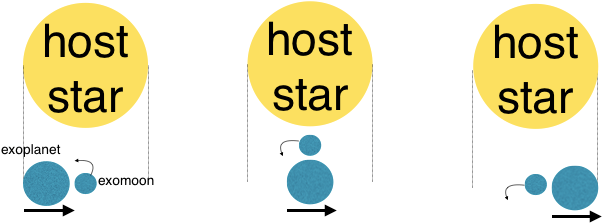GAM 2018 Blog
- Published: Sunday, April 15 2018 09:00
By Meirin Evans
Our planet has only one moon, but there are all together over 100 moons around the other planets in our Solar System. The Universe should be teeming with moons which orbit around planets which themselves orbit around other stars. Planets in other stellar systems are called exoplanets (extra-solar planets) and so moons in other stellar systems are called exomoons. Exoplanets were only discovered in the last 25 years. Will the next 25 years see the discovery of exomoons? There has long been speculation that other moons in our own solar system might have hosted life, so the discovery of exomoons would increase the chances in the ultimate quest of finding life elsewhere in the Universe.
The presence of an exomoon would cause a small shift in the orbit of an exoplanet around its host star. Therefore, here on Earth, we’d look for timing variations in the orbit of an exoplanet. However, the presence of other exoplanets in the same stellar system could also induce a timing variation. Hence, we need something to differentiate between a timing variation from another exoplanet and that from an exomoon. To identify an exomoon we can look for both a transit duration variation (TDV) and transit timing variation (TTV) in the same system. Detection of both would confirm the presence of an exomoon. With TTV, the exoplanet transit would occur at slightly different times for each of its orbits around the host star. With TDV, the total duration of the exoplanet transit changes periodically. TTV and TDV signals should be 900 degrees out of phase, just like the sin & cos functions in maths. The combination of TTV and TDV signals exhibiting a 90 ̊ phase difference would be the confirmation of an exomoon.
Our best chance of detecting an exomoon would be for an edge on orbit of an exoplanet around its host star. This is like seeing the edge of a flat pancake, and not being able to see the top or bottom. Additionally, the exomoon orbit around its exoplanet would be “coplanar”, i.e. the exomoon orbit would also be in the edge of the pancake. In this scenario, the exoplanet and exomoon would move in and out of the pancake, and not up or down from the pancake. In Figure 1, we imagine looking at this pancake from the top, onto its surface. For a Moon-like exomoon orbiting around an Earth-like exoplanet orbiting around a Sun-like star we could expect a TDV signal of 18 seconds, very small on astronomical timescales…

Figure 1: A schematic diagram of an exomoon orbiting around an exoplanet, which itself is orbiting around a host star elsewhere in our galaxy. Sizes and distances are not drawn to scale.
Recent simulations have given promising results suggesting that exomoon detections are on the horizon. Indeed, one of the next few major satellite surveys may provide this first exomoon discovery, which could bring us a tiny step closer to finding life elsewhere in the universe.
|
Meirin is nearing the end of his master's degree in Physics from the University of Manchester. He is interested in many aspects of physics education, teaching, outreach, science communication & public engagement, including writing popular science blogs such as this one. |
 |









